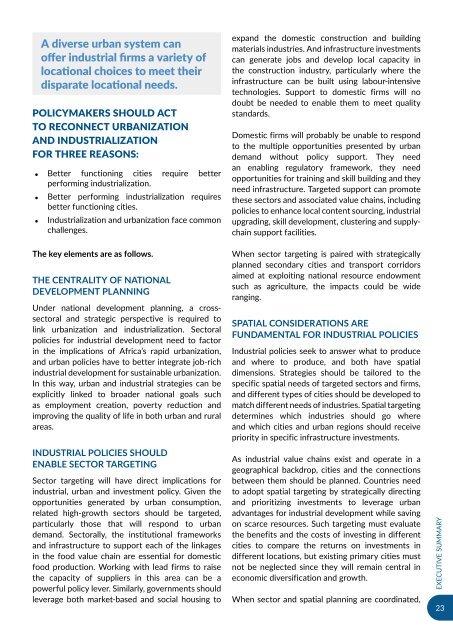URBANIZATION AND INDUSTRIALIZATION
Economic%20Report%20on%20Africa%202017%20UNECA
Economic%20Report%20on%20Africa%202017%20UNECA
Create successful ePaper yourself
Turn your PDF publications into a flip-book with our unique Google optimized e-Paper software.
A diverse urban system can<br />
offer industrial firms a variety of<br />
locational choices to meet their<br />
disparate locational needs.<br />
POLICYMAKERS SHOULD ACT<br />
TO RECONNECT <strong>URBANIZATION</strong><br />
<strong>AND</strong> <strong>INDUSTRIALIZATION</strong><br />
FOR THREE REASONS:<br />
Better functioning cities require better<br />
performing industrialization.<br />
Better performing industrialization requires<br />
better functioning cities.<br />
Industrialization and urbanization face common<br />
challenges.<br />
The key elements are as follows.<br />
THE CENTRALITY OF NATIONAL<br />
DEVELOPMENT PLANNING<br />
Under national development planning, a crosssectoral<br />
and strategic perspective is required to<br />
link urbanization and industrialization. Sectoral<br />
policies for industrial development need to factor<br />
in the implications of Africa’s rapid urbanization,<br />
and urban policies have to better integrate job-rich<br />
industrial development for sustainable urbanization.<br />
In this way, urban and industrial strategies can be<br />
explicitly linked to broader national goals such<br />
as employment creation, poverty reduction and<br />
improving the quality of life in both urban and rural<br />
areas.<br />
INDUSTRIAL POLICIES SHOULD<br />
ENABLE SECTOR TARGETING<br />
Sector targeting will have direct implications for<br />
industrial, urban and investment policy. Given the<br />
opportunities generated by urban consumption,<br />
related high-growth sectors should be targeted,<br />
particularly those that will respond to urban<br />
demand. Sectorally, the institutional frameworks<br />
and infrastructure to support each of the linkages<br />
in the food value chain are essential for domestic<br />
food production. Working with lead firms to raise<br />
the capacity of suppliers in this area can be a<br />
powerful policy lever. Similarly, governments should<br />
leverage both market-based and social housing to<br />
expand the domestic construction and building<br />
materials industries. And infrastructure investments<br />
can generate jobs and develop local capacity in<br />
the construction industry, particularly where the<br />
infrastructure can be built using labour-intensive<br />
technologies. Support to domestic firms will no<br />
doubt be needed to enable them to meet quality<br />
standards.<br />
Domestic firms will probably be unable to respond<br />
to the multiple opportunities presented by urban<br />
demand without policy support. They need<br />
an enabling regulatory framework, they need<br />
opportunities for training and skill building and they<br />
need infrastructure. Targeted support can promote<br />
these sectors and associated value chains, including<br />
policies to enhance local content sourcing, industrial<br />
upgrading, skill development, clustering and supplychain<br />
support facilities.<br />
When sector targeting is paired with strategically<br />
planned secondary cities and transport corridors<br />
aimed at exploiting national resource endowment<br />
such as agriculture, the impacts could be wide<br />
ranging.<br />
SPATIAL CONSIDERATIONS ARE<br />
FUNDAMENTAL FOR INDUSTRIAL POLICIES<br />
Industrial policies seek to answer what to produce<br />
and where to produce, and both have spatial<br />
dimensions. Strategies should be tailored to the<br />
specific spatial needs of targeted sectors and firms,<br />
and different types of cities should be developed to<br />
match different needs of industries. Spatial targeting<br />
determines which industries should go where<br />
and which cities and urban regions should receive<br />
priority in specific infrastructure investments.<br />
As industrial value chains exist and operate in a<br />
geographical backdrop, cities and the connections<br />
between them should be planned. Countries need<br />
to adopt spatial targeting by strategically directing<br />
and prioritizing investments to leverage urban<br />
advantages for industrial development while saving<br />
on scarce resources. Such targeting must evaluate<br />
the benefits and the costs of investing in different<br />
cities to compare the returns on investments in<br />
different locations, but existing primary cities must<br />
not be neglected since they will remain central in<br />
economic diversification and growth.<br />
When sector and spatial planning are coordinated,<br />
EXECUTIVE SUMMARY<br />
23


